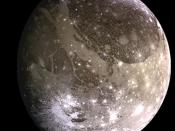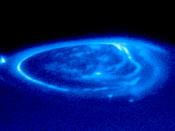Jupiter and its Galilean Satellites
Jupiter
Orbit: 778,330,000 km (5.20 AU) from Sun
Diameter: 142,984 km (equatorial)
Mass: 1.900e27 kg
Jupiter is the fourth brightest object in the night sky and is also the biggest planet in our solar system. In fact it's so big you can put 100 Earths around it. One of the main reasons it is so big is the volume of its gases, which are 90 percent hydrogen, and 10 percent helium and traces of methane, water, and ammonia. The sun contains 99.8 percent of the matter in our solar system and Jupiter contains 70 percent of what is left.
Jupiter has a magnetosphere that stretches for 650 million km kilometers beyond the planet making it the largest single structure in the universe, and is caused by a liquid hydrogen metallic layer. This liquid hydrogen metallic layer is caused by Jupiter's enormous atmospheric pressure near the center of the planet, which is caused by Jupiter's thick cloud cover.
This pressure causes the liquid hydrogen ocean into a form of liquid hydrogen that acts like a metal. This liquid hydrogen metallic layer may surround a rock core about the same size of the earth: temperatures in Jupiter's core may reach 30,000 Celsius.
There is great red spot on Jupiter, which is thought to be a hurricane. The great red spot is an oval about 12,000 by 25,000 km, big enough to hold two Earths. It is also a high-pressure region whose cloud tops are significantly higher and colder than the surrounding areas.
Jupiter also has very thing rings and these rings where discovered by Voyager 1. Jupiter's rings are dark unlike Saturn's rings; they're theorized to be made of very small grains of rock material and contain no ice. Particles in Jupiter's rings probably don't stay there...


